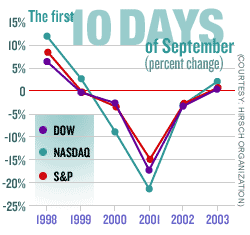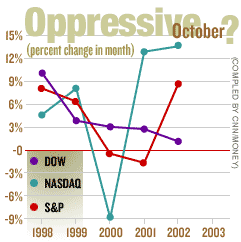NEW YORK (CNN/Money) -
Despite ending the month with losses after a stellar start, the Dow, S&P 500 and Nadsaq still enjoyed their strongest September since 1998. But Wall Streeters, used to selloffs and crashes this time of the year, are still skeptical about the market's ability to put up gains in October.
"You always hear that September and October are bad months for the stock market, especially October," said Bill Roe, portfolio manager at Melhado Flynn & Associates. "I think there's a lot of caution. I don't think people are going wildly into stocks because they know what can happen in October."

While ending a month lower isn't necessarily a good thing, this time the three major indexes demonstrated resilience during a month of traditional weakness. The Nasdaq composite index ended the month 1.2 percent lower after putting up gains of 4.3 percent in its first five trading days -- its second best early-September run in the past 15 years, according to the Hirsch Organization, publishers of the Stock Traders Almanac. The Nasdaq managed a better close than it has in the past four years, which averaged losses of about 10 percent.
Meanwhile, the Dow and the S&P also saw their best Septembers in four years, despite ending 1.3 percent and 1.2 percent lower for the month, respectively. Like the Nasdaq, the Dow and the S&P also had gains in the first 10 trading days of the month that were much better than their averages over the past 15 years. And while they did end up losers, the Dow did much better than its average loss of 8.3 percent over the past four September, while the S&P narrowed its loss from 6.9 percent during the same time period.
Thanks to the market crashes of 1929 and 1987, as well as the wild rides of the late 1990s, October has the reputation of being a "jinx month" for the market. But it can also be a turnaround month for stocks -- it was that in 1998 and 1999. Despite significant drops at the beginning of October in those years, stocks managed to end the month with big gains.
Earnings will rule
With the economy on the rebound and the market on a bull ride since March, stocks are likely to take their cue from the third-quarter earnings reports that are set to start rolling in mid-October. And the earnings season is expected to be strong. Already, the number of companies upwardly revising their guidance has grown about 20 percent from the same period last year.
"There's no doubt that earnings are going to be better, said Jon Burnham, portfolio manager at Burnham Securities.
Investors got their first taste of corporate America's bottom line performance when a handful of financial services companies began posting their results in mid-September. Despite their exposure to rising interest rates, five of Wall Street's heavyweights reported stellar results.

Bear Stearns (BSC: Research, Estimates) and A.G. Edwards (AGE: Research, Estimates) each reported quarterly earnings September 18 that soared past Wall Street's estimates. Bear Stearns' bottom line was helped especially by its thriving bond business, even in the face of rising rates.
Goldman Sachs (GS: Research, Estimates), Lehman Brothers (LEH: Research, Estimates) and Morgan Stanley (MWD: Research, Estimates) also delivered on expectations when they September 23, helping to lift the entire financial sector and the broader stock market.
"A lot of people were concerned about how the back-up in interest rates was going to affect these companies," said Reilly Tierney, financial analyst at Fox, Pitt Kelton. "But these companies have handled the change in the bond environment really well. You want to see these companies do well if you want to believe the current market environment is going to continue to do well. These are leading indicator-type stocks."
The third quarter may have been a strong one for investment companies, but banks with large mortgage businesses probably got stung by the late summer rise in interest rates. Two of the top three mortgage lenders, Washington Mutual (WM: Research, Estimates) and Countrywide Financial (CFC: Research, Estimates) warned last month that they suffered large declines in mortgage applications in August from the prior month. Washington Mutual said it would take a loss for the sale of mortgages in the third quarter. Countrywide Financial is set to report quarterly results on Oct. 21, while Washington Mutual's report is due on Oct. 14.
With a little help from the Fed
Despite Wall Street's interest rate anxiety, the Federal Reserve's stated commitment to keep rates low, reiterated in comments after its last policy meeting in September, also has the potential to keep optimism up in October. Add to that economists' projections that the economy will grow at a rate of 4.5 percent in the third quarter, from 2.4 percent in the second quarter and the basis could be there for an unusually strong and smooth October for stocks.
Yet, many market watchers are still wary. As of Tuesday's close, the Dow has risen 11.2 percent so far this year and the S&P has gained 13.2 percent. The Nasdaq has jumped a whopping 33.8 percent.
This runup has some money managers nervous. They also worry about continued tensions in Iraq and the Middle East and a labor market that has yet to show signs of better health.
"October can be a difficult month, so I don't want to bet on October," Burnham said. "But I don't think it will be terrible."

|

